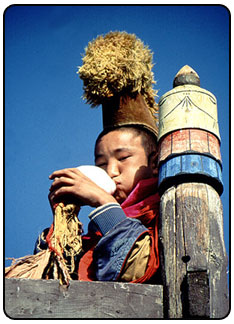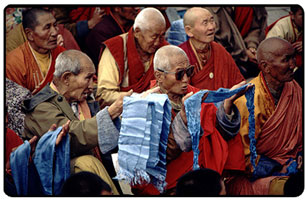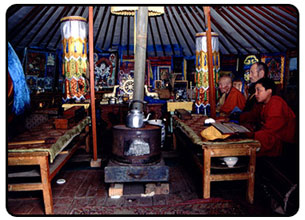|
 Early
Mongolian contacts with Buddhism are dated to the fourth century,
when the activities of Chinese monks among the population of this
border area are reported in contemporary Chinese sources. Buddhist
influences spread as far as the Yenisei region by the seventh century,
as evidenced by Buddhist temple bells with Chinese inscriptions
found there. Another factor in the spread of Buddhism into Mongolia
was the flourishing of Buddhist communities in the predominantly
Uighur oasis states along the Silk Route. Furthermore, the palace
that was built by Ogedei Khan (1229-1241) in Karakorum, the Mongol
capital, was constructed on the foundations of a former Buddhist
temple; some of the murals from this temple have been preserved,
Sources for this early Buddhist activity are rather scarce. Early
Mongolian contacts with Buddhism are dated to the fourth century,
when the activities of Chinese monks among the population of this
border area are reported in contemporary Chinese sources. Buddhist
influences spread as far as the Yenisei region by the seventh century,
as evidenced by Buddhist temple bells with Chinese inscriptions
found there. Another factor in the spread of Buddhism into Mongolia
was the flourishing of Buddhist communities in the predominantly
Uighur oasis states along the Silk Route. Furthermore, the palace
that was built by Ogedei Khan (1229-1241) in Karakorum, the Mongol
capital, was constructed on the foundations of a former Buddhist
temple; some of the murals from this temple have been preserved,
Sources for this early Buddhist activity are rather scarce.
Reports in Mongolian
sources on the early spread of Buddhism shroud these missionary
activities in a cloak of mysterious events that testify to the superiority
of Tantric Buddhism over other religions during the reign of Khublai
Khan (1260-1294). Contacts with the Sa-skya pandita Kun-dga'rgyal-mtshan
(1182-1251) were established during Ogedei's reign, but Buddhism
only gained influence with the Mongols after their expeditions into
Tibet, which resulted in the sojourn of Tibetan monks as hostages
at the Mongol court. The activities there of the lama (Tib., bla
ma) 'Phags pa (1235-1280) resulted in an increase in conversions
to Buddhism, his invention, in 1269, of a block script led to the
translation into Mongolian of great numbers of Buddhist religious
literature, the translations often based on already existing Uighur
translations. The legend that Chinggis Khan had previously invited
the Sa-skya abbot Kun-dga'-snin-po (1092-1158) lacks proof.
In spite of
the extensive translation and printing of Buddhist tracts, conversion
seems to have been limited to the nobility and the ruling families.
Judging from the Mongols' history of religious tolerance, it is
rather doubtful that Buddhism spread among the general population
on a large scale. Syncretic influences resulted in the transformation
of popular gods into Buddhist deities and the acceptance of notions
from other religions during this period.
 After
Mongol rule over China ended in 1368 the practice of Buddhism diminished
among the Mongols, deteriorating into mere superstition or giving
way once again to the indigenous religious conceptions of the Mongols
and to shamanism. It was not until the sixteenth century that a
second wave of Buddhist conversion began, brought about by the military
expeditions of Allan Khan of the Tumet (1507-1583) into the eastern
border districts of Tibet, which resulted in contacts with lamaist
clerics. Within the short period of fifty years, beginning with
the visit of the third Dalai Lama to Allan Khan's newly built residence,
Koke Khota, in 1578, practically all of the Mongolian nobility was
converted to Buddhism by the missionary work of many devoted lamaist
priests. The most famous of these were Neyici Toyin (1557-1653),
who converted the eastern Mongols, and Zaya Pandita, who converted
the western and northern Mongols. Sustained by princes and overlords
who acted according to the maxim "huius regio, eius religio,"
inducing the adoption of the new faith by donations of horses, dairy
animals, and money, the population willingly or forcedly took to
Lamaism. Shamanism was outlawed, idols sought out and burned. The
establishment of many new monasteries opened to a greater part of
the population the opportunity to become monks, resulting in a drain
on Mongolian manpower. The monasteries, however, became similar
to those of early medieval Europe; they were the cradles of literature
and science, particularly of Buddhist philosophy. By 1629 many other
lamaist works were translated into Mongolian, including the 1,161
volumes of the lamaist canon, the Bka'-'gyur (Kanjur). Tibetan became
the lingua franca of the clerics, as Latin was in medieval Europe,
with hundreds of religious works written in this language. After
Mongol rule over China ended in 1368 the practice of Buddhism diminished
among the Mongols, deteriorating into mere superstition or giving
way once again to the indigenous religious conceptions of the Mongols
and to shamanism. It was not until the sixteenth century that a
second wave of Buddhist conversion began, brought about by the military
expeditions of Allan Khan of the Tumet (1507-1583) into the eastern
border districts of Tibet, which resulted in contacts with lamaist
clerics. Within the short period of fifty years, beginning with
the visit of the third Dalai Lama to Allan Khan's newly built residence,
Koke Khota, in 1578, practically all of the Mongolian nobility was
converted to Buddhism by the missionary work of many devoted lamaist
priests. The most famous of these were Neyici Toyin (1557-1653),
who converted the eastern Mongols, and Zaya Pandita, who converted
the western and northern Mongols. Sustained by princes and overlords
who acted according to the maxim "huius regio, eius religio,"
inducing the adoption of the new faith by donations of horses, dairy
animals, and money, the population willingly or forcedly took to
Lamaism. Shamanism was outlawed, idols sought out and burned. The
establishment of many new monasteries opened to a greater part of
the population the opportunity to become monks, resulting in a drain
on Mongolian manpower. The monasteries, however, became similar
to those of early medieval Europe; they were the cradles of literature
and science, particularly of Buddhist philosophy. By 1629 many other
lamaist works were translated into Mongolian, including the 1,161
volumes of the lamaist canon, the Bka'-'gyur (Kanjur). Tibetan became
the lingua franca of the clerics, as Latin was in medieval Europe,
with hundreds of religious works written in this language.
During the Ch'ing
dynasty in China, particularly during the K'ang-hsi, Yung-cheng,
and Ch'ien-lung reign periods, the printing of Buddhist works in
Mongolian was furthered by the Manchu emperors as well as by the
Mongolian nobility. Donating money for copying scripture, cutting
printing blocks, and printing Buddhist works were thought of as
meritorious deeds. Works on medicine, philosophy, and history were
also published and distributed. The spiritual life of Mongolia became
strongly influenced by religious and semi-religious thoughts and
ethics. Sponsored by the K'ang hsi emperor, a revised edition of
the Mongolian Bka''-gyur was printed from 1718 to 1720; translation
of the Bstan-'gyur (Tanjur) was begun under the Ch'ien-lung emperor
in 1741 and was completed in 1749. Copies of the completed edition
(in 108 and 223 volumes, respectively, for the Bka'-'gyur and Bstan'-'gyur)
were given as imperial gifts to many monasteries throughout Mongolia.
In the eighteenth
century elements of indigenous Mongolian mythology were incorporated
into a national liturgy  composed
entirely in Mongolian. A century later there were about twelve hundred
lamaist temples and monasteries in Inner Mongolia and more than
seven hundred in the territory of the present-day Mongolian People's
Republic. More than a third of the entire male population of Mongolia
belonged to the clergy. The monasteries, possessing their own economic
system and property, formed a separate administrative and political
organization. In the twentieth century the decline of monasteries
and Lamaism was brought about by inner strife and a changing moral
climate as well as by political movements and new ideologies. Recently
have some monasteries been reopened in the Mongolian parts of China,
in the Mongolian People's Republic, and in Buriat-Mongolia in the
former U.S.S.R., but the question of whether the younger members
of the population will embrace the faith again remains open. composed
entirely in Mongolian. A century later there were about twelve hundred
lamaist temples and monasteries in Inner Mongolia and more than
seven hundred in the territory of the present-day Mongolian People's
Republic. More than a third of the entire male population of Mongolia
belonged to the clergy. The monasteries, possessing their own economic
system and property, formed a separate administrative and political
organization. In the twentieth century the decline of monasteries
and Lamaism was brought about by inner strife and a changing moral
climate as well as by political movements and new ideologies. Recently
have some monasteries been reopened in the Mongolian parts of China,
in the Mongolian People's Republic, and in Buriat-Mongolia in the
former U.S.S.R., but the question of whether the younger members
of the population will embrace the faith again remains open.
Walther
Heissig
Heissig, Walther, Die Pekinger lamaistischen Blockdrucke
in mongolischer Sprache. Wiesbaden, 1954.
Heissig,
Walther. "Zur geistigen Leistung der neubekehrten Mongolen
des spaten 16. and fruhen 17. Jahrhunderts:" Ural-Altaische
Jahrbucher 26 (1954): 101-116.
Heissig, Walther. The Religions of Mongolia. Translated by Geoffrey
Samuel. Berkeley, 1980.
Photographs by Sue Byrne (Programme
Manager)
Buddhism in Mongolia Programme, Tibet Foundation, 1 St James's Market
London SW1Y 4SB UK
|

 Early
Mongolian contacts with Buddhism are dated to the fourth century,
when the activities of Chinese monks among the population of this
border area are reported in contemporary Chinese sources. Buddhist
influences spread as far as the Yenisei region by the seventh century,
as evidenced by Buddhist temple bells with Chinese inscriptions
found there. Another factor in the spread of Buddhism into Mongolia
was the flourishing of Buddhist communities in the predominantly
Uighur oasis states along the Silk Route. Furthermore, the palace
that was built by Ogedei Khan (1229-1241) in Karakorum, the Mongol
capital, was constructed on the foundations of a former Buddhist
temple; some of the murals from this temple have been preserved,
Sources for this early Buddhist activity are rather scarce.
Early
Mongolian contacts with Buddhism are dated to the fourth century,
when the activities of Chinese monks among the population of this
border area are reported in contemporary Chinese sources. Buddhist
influences spread as far as the Yenisei region by the seventh century,
as evidenced by Buddhist temple bells with Chinese inscriptions
found there. Another factor in the spread of Buddhism into Mongolia
was the flourishing of Buddhist communities in the predominantly
Uighur oasis states along the Silk Route. Furthermore, the palace
that was built by Ogedei Khan (1229-1241) in Karakorum, the Mongol
capital, was constructed on the foundations of a former Buddhist
temple; some of the murals from this temple have been preserved,
Sources for this early Buddhist activity are rather scarce.
 After
Mongol rule over China ended in 1368 the practice of Buddhism diminished
among the Mongols, deteriorating into mere superstition or giving
way once again to the indigenous religious conceptions of the Mongols
and to shamanism. It was not until the sixteenth century that a
second wave of Buddhist conversion began, brought about by the military
expeditions of Allan Khan of the Tumet (1507-1583) into the eastern
border districts of Tibet, which resulted in contacts with lamaist
clerics. Within the short period of fifty years, beginning with
the visit of the third Dalai Lama to Allan Khan's newly built residence,
Koke Khota, in 1578, practically all of the Mongolian nobility was
converted to Buddhism by the missionary work of many devoted lamaist
priests. The most famous of these were Neyici Toyin (1557-1653),
who converted the eastern Mongols, and Zaya Pandita, who converted
the western and northern Mongols. Sustained by princes and overlords
who acted according to the maxim "huius regio, eius religio,"
inducing the adoption of the new faith by donations of horses, dairy
animals, and money, the population willingly or forcedly took to
Lamaism. Shamanism was outlawed, idols sought out and burned. The
establishment of many new monasteries opened to a greater part of
the population the opportunity to become monks, resulting in a drain
on Mongolian manpower. The monasteries, however, became similar
to those of early medieval Europe; they were the cradles of literature
and science, particularly of Buddhist philosophy. By 1629 many other
lamaist works were translated into Mongolian, including the 1,161
volumes of the lamaist canon, the Bka'-'gyur (Kanjur). Tibetan became
the lingua franca of the clerics, as Latin was in medieval Europe,
with hundreds of religious works written in this language.
After
Mongol rule over China ended in 1368 the practice of Buddhism diminished
among the Mongols, deteriorating into mere superstition or giving
way once again to the indigenous religious conceptions of the Mongols
and to shamanism. It was not until the sixteenth century that a
second wave of Buddhist conversion began, brought about by the military
expeditions of Allan Khan of the Tumet (1507-1583) into the eastern
border districts of Tibet, which resulted in contacts with lamaist
clerics. Within the short period of fifty years, beginning with
the visit of the third Dalai Lama to Allan Khan's newly built residence,
Koke Khota, in 1578, practically all of the Mongolian nobility was
converted to Buddhism by the missionary work of many devoted lamaist
priests. The most famous of these were Neyici Toyin (1557-1653),
who converted the eastern Mongols, and Zaya Pandita, who converted
the western and northern Mongols. Sustained by princes and overlords
who acted according to the maxim "huius regio, eius religio,"
inducing the adoption of the new faith by donations of horses, dairy
animals, and money, the population willingly or forcedly took to
Lamaism. Shamanism was outlawed, idols sought out and burned. The
establishment of many new monasteries opened to a greater part of
the population the opportunity to become monks, resulting in a drain
on Mongolian manpower. The monasteries, however, became similar
to those of early medieval Europe; they were the cradles of literature
and science, particularly of Buddhist philosophy. By 1629 many other
lamaist works were translated into Mongolian, including the 1,161
volumes of the lamaist canon, the Bka'-'gyur (Kanjur). Tibetan became
the lingua franca of the clerics, as Latin was in medieval Europe,
with hundreds of religious works written in this language. composed
entirely in Mongolian. A century later there were about twelve hundred
lamaist temples and monasteries in Inner Mongolia and more than
seven hundred in the territory of the present-day Mongolian People's
Republic. More than a third of the entire male population of Mongolia
belonged to the clergy. The monasteries, possessing their own economic
system and property, formed a separate administrative and political
organization. In the twentieth century the decline of monasteries
and Lamaism was brought about by inner strife and a changing moral
climate as well as by political movements and new ideologies. Recently
have some monasteries been reopened in the Mongolian parts of China,
in the Mongolian People's Republic, and in Buriat-Mongolia in the
former U.S.S.R., but the question of whether the younger members
of the population will embrace the faith again remains open.
composed
entirely in Mongolian. A century later there were about twelve hundred
lamaist temples and monasteries in Inner Mongolia and more than
seven hundred in the territory of the present-day Mongolian People's
Republic. More than a third of the entire male population of Mongolia
belonged to the clergy. The monasteries, possessing their own economic
system and property, formed a separate administrative and political
organization. In the twentieth century the decline of monasteries
and Lamaism was brought about by inner strife and a changing moral
climate as well as by political movements and new ideologies. Recently
have some monasteries been reopened in the Mongolian parts of China,
in the Mongolian People's Republic, and in Buriat-Mongolia in the
former U.S.S.R., but the question of whether the younger members
of the population will embrace the faith again remains open.